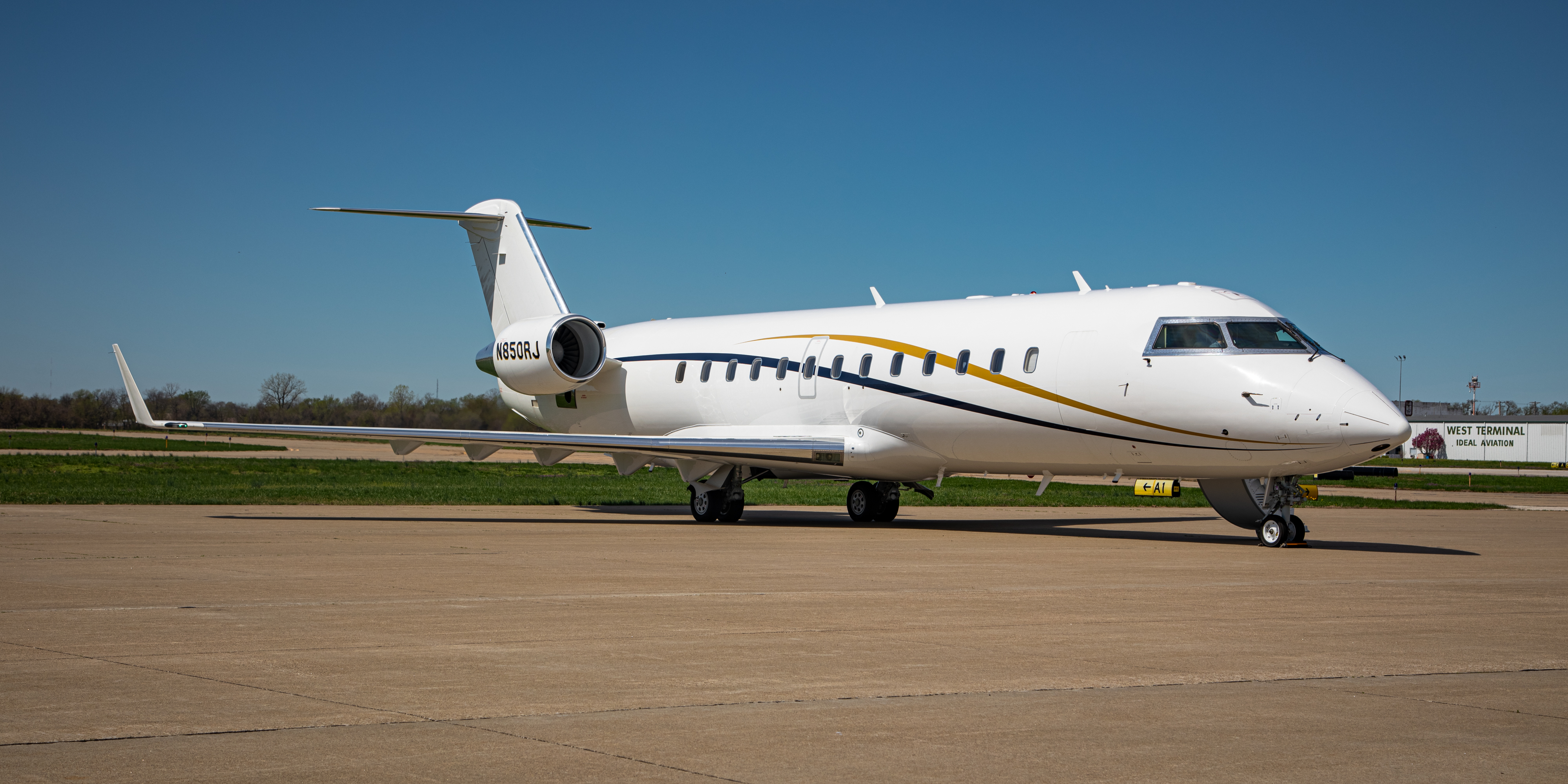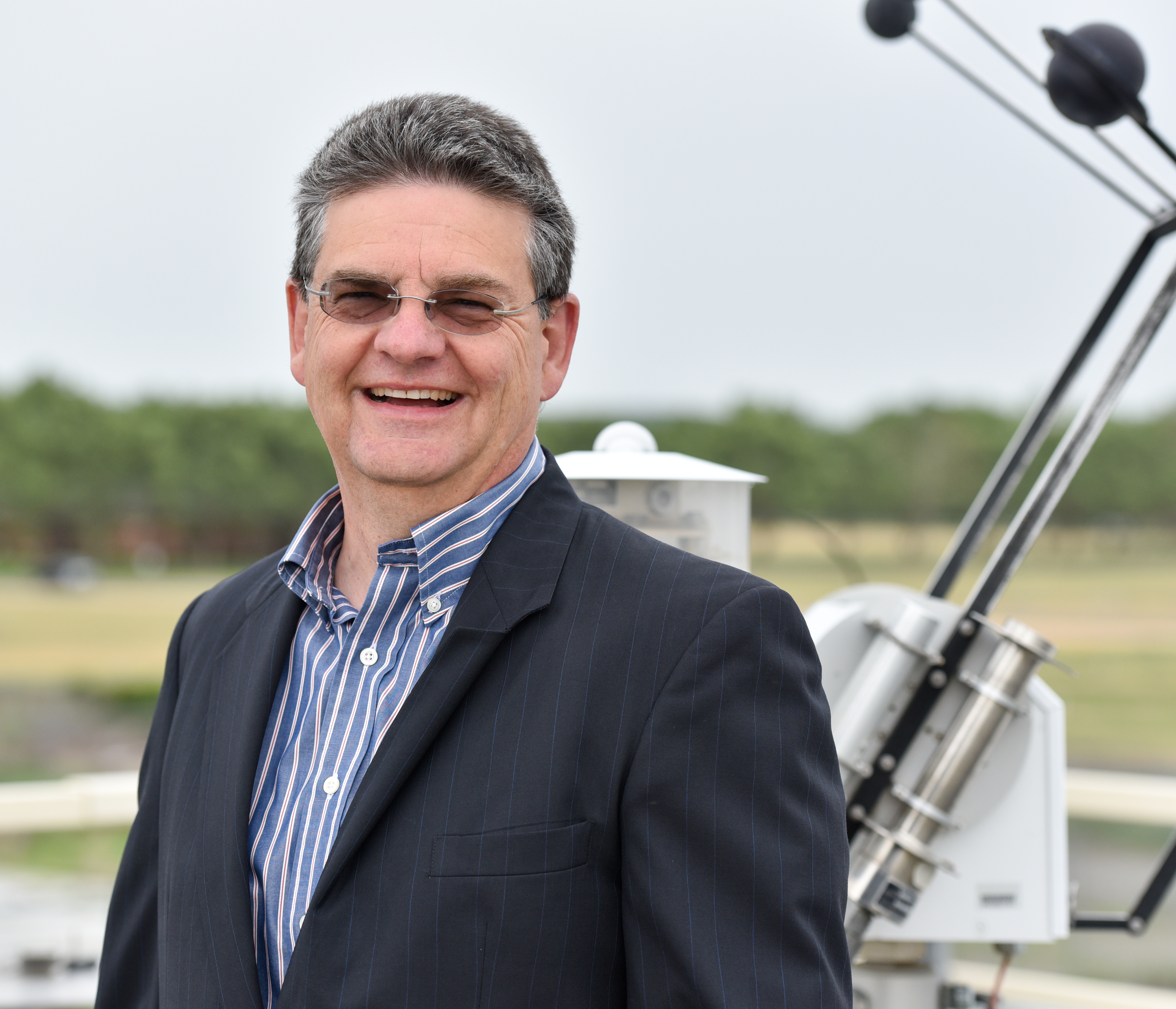ARM’s New Laboratory in the Sky
Published: 24 June 2019
ARM Aerial Facility Purchases Bombardier Challenger 850 Regional Jet

Higher, faster, farther, and stronger. These four words summarize the future of the Atmospheric Radiation Measurement (ARM) Aerial Facility’s (AAF) airborne measurement capability.
The AAF recently closed on the purchase of a Bombardier Challenger 850 regional jet, a replacement for ARM’s vintage Grumman Gulfstream-159 (G-1) turboprop aircraft that—for three decades—helped advance atmospheric research in field campaigns across the world.
According to ARM Aerial Facility Manager Beat Schmid, the Challenger 850—despite entering service in 1998—is “virtually new,” having logged less than 2,600 takeoffs and landings and fewer than 5,500 airframe/engine hours. The jet was built and used as a business jet, stored out of the elements in a hangar, and it was repainted in 2015.
Manufactured by Bombardier until 2012, the Challenger 850 was the largest “super-mid-size” business jet offered by Bombardier. A typical configuration for the airline version of this airframe (Bombardier CRJ 200) has about 50 passenger seats.
“This is a big step forward in ARM’s data collection capabilities. It will allow us to offer the science community additional types of aerial sampling, the power to climb and descend more quickly within desired areas of interest, and the ability to fly much higher.”
Beat Schmid, ARM Aerial Facility manager
“For ARM and our researchers, this space means we will have the ability to carry more instruments and more researchers,” explains Schmid, noting that—depending on the instrument configuration—there may be room for up to seven scientists. “With the old G-1, we were often limited, and that meant there was often no room for campaign investigators.”

Not only does the new jet have the old G-1’s capability of flying low and slow for some experiments, but it also can venture into higher elevations and more safely fly through and collect data in stormy weather conditions. The G-1 could reach a top elevation for scientific study of around 20,000 feet. The Challenger 850 doubles that to 40,000 feet (depending on ambient temperature and weight, primarily determined by instrument payload and fuel volume).
“This is a big step forward in ARM’s data collection capabilities,” says Schmid. “It will allow us to offer the science community additional types of aerial sampling, the power to climb and descend more quickly within desired areas of interest, and the ability to fly much higher. For example, we will now be able to sample high cirrus clouds.”
With a much larger geographic range, Schmid says the new jet will also greatly expand the range that AAF instruments can easily reach far-flung field campaigns. “We’re very excited about the aircraft, its capabilities, and how it will help us to continue to serve the needs of the science community.”
A Long Flight to New Science Missions
The need to replace ARM’s previous airplane, the G-1, was no surprise to program managers at the U.S. Department of Energy (DOE). An effort to secure funding for a new aircraft began in 2016 and concluded with Congress allocating fiscal year 2019 funding of $17.5 million to purchase and retrofit a new research aircraft.
That congressional allocation was the linchpin of a long multistep process, stewarded by leadership at Pacific Northwest National Laboratory (PNNL), to establish the aircraft requirements and ultimately solicit bids and award a purchase. The criteria for a new aircraft included:
- have payload capacity to carry multisensor packages for concurrent measurements of aerosol, trace gas, clouds, and solar and infrared radiation
- have a physical structure that allows the installation of in-cabin instruments, free-airstream sensors, and radiometers
- able to fly between the surface and 25,000 feet to gather data on a range of scientific priorities, including information on land-atmosphere interactions, boundary layer structure, and mixed-phase cloud microphysics
- able to fuel-efficiently fly safely as low as 200 feet to gather in situ observations of aerosol and cloud microphysical properties
- able to operate in conditions ranging from the Arctic to the tropics with a full payload
- have a flight duration of at least five hours with a full payload
- capable of flying during atmospheric phenomena of interest
- able to conduct multiweek to multimonth campaign deployments worldwide
- consistent with commonly available aircraft support infrastructure.
In anticipation of the new jet, the Port of Pasco, Washington (home of the AAF) partnered with PNNL, DOE, the Washington State Community Economic Revitalization Board, and the Franklin County Economic Development Fund to break ground on a larger hangar. Construction of the $3.4 million, 18,240-square-foot facility is expected to be completed by October 2019.

The Challenger 850 will be modified from its current business jet configuration to accommodate ARM instrumentation, both within and outside the aircraft. Modifying a business jet for research is not simple but will include cabin reconfiguration, power system design and installation for instrumentation, external instrumentation installation, and the design, fabrication, and installation of wing pylons (modular structures on the aircraft used to mount a variety of instrumentation).
After the modification phase, the aircraft will enter a scientific readiness phase. The installed scientific systems will be tested, pylons will be adjusted to be in line with airflow, modernized data acquisition will be installed, and inlets mounted. The Challenger will have three inlets that bring in ambient air—one each for droplets/ice crystals, aerosols, and trace gasses. Numerous test flights will be conducted with a full complement of instruments to verify readiness for the ARM scientific mission.
Meanwhile, existing and yet-to-be-hired AAF pilots and maintenance staff will be trained on the new airframe. With everything considered, Schmid does not expect the new research aircraft to fly its first ARM campaign until fiscal year 2022 or 2023.
The ARM Aerial Facility
The AAF provides airborne observations and participates in ARM field campaigns proposed by the scientific community that contribute to the fundamental understanding of clouds, aerosols, and radiation. To ensure that the best airborne data sets are collected, AAF scientists and engineers assess the capabilities of existing instruments and technology under development within the airborne measurement community. New instruments are integrated into the AAF suite to fill current measurement gaps, as needed.
Working with instrument developers from national laboratories, universities, and private industry, the AAF takes an active role in new instrument development, particularly in the area of miniaturization, where existing instrumentation is merged with new technology to better fit within the tight confines of an airplane.
During ARM field campaigns, the AAF provides a unique record of the atmospheric state and constituents that affect Earth’s surface radiation budget. AAF scientists and engineers work with researchers to develop flight plans that meet scientific requirements and then obtain approvals from civilian and military aviation authorities and other stakeholders. This work includes required safety reviews and interagency coordination for joint campaigns and coordinated flights.
After a campaign, the AAF team ensures data quality, and documents data, and archives data sets (freely available on ARM Data Discovery) that include:
- in situ measurements of aerosols, clouds, and trace gases
- sampling not possible using surface- or satellite-based techniques
- measurements for validating surface- or satellite-based techniques
- context for and extension of surface-based measurements
- measurements for testing and evaluating models.
Specifications and Capabilities of the Challenger 850
The following lists some of the specifications and capabilities of the unmodified Challenger 850 aircraft:
- flight crew: 2
- overall length: 87.83 feet
- wingspan: 69.58 feet
- cabin length: 48.42 feet
- cabin width: 7.17 feet
- cabin height: 6.08 feet
- floor area: 346 square feet
- engines: General Electric CF34-3B1 turbofans
- range: 2,811 nautical miles
- typical cruise speed: 509 mph
- takeoff distance: 6,305 feet
- landing distance: 2,910 feet
- maximum altitude: 41,000 feet.
Note: With AAF modifications for scientific research, some performance characteristics may be affected by external instrumentation. Once the AAF-modified Challenger 850 takes to the air, a typical short list of instrumentation and measurement capabilities may include:
- atmospheric and aircraft state measurements
- cloud liquid water content (PVM, WCM)
- cloud droplet probe (CDP)
- 2-dimensional stereo probe (2D-S)
- high-volume precipitation spectrometer version 3 (HVPS-3)
- cloud particle imager (CPI).
- ultra-high-sensitivity aerosol spectrometer (UHSAS)
- scanning mobility particle sizer (SMPS)
- single-particle soot photometer (SP2)
- dual-column cloud condensation nuclei counter (Dual-CCNC)
- condensation particle counter (CPC)
- ultrafine CPC (UCPC)
- aerosol mass spectrometers
- trace gas system (measuring concentrations of sulfur dioxide, carbon monoxide, ozone, nitrogen monoxide, nitrogen dioxide, and nitrogen oxide)
- cavity ring-down spectrometer (measuring concentrations of carbon dioxide, methane, and water).
Keep up with the Atmospheric Observer
Updates on ARM news, events, and opportunities delivered to your inbox
ARM User Profile
ARM welcomes users from all institutions and nations. A free ARM user account is needed to access ARM data.


















